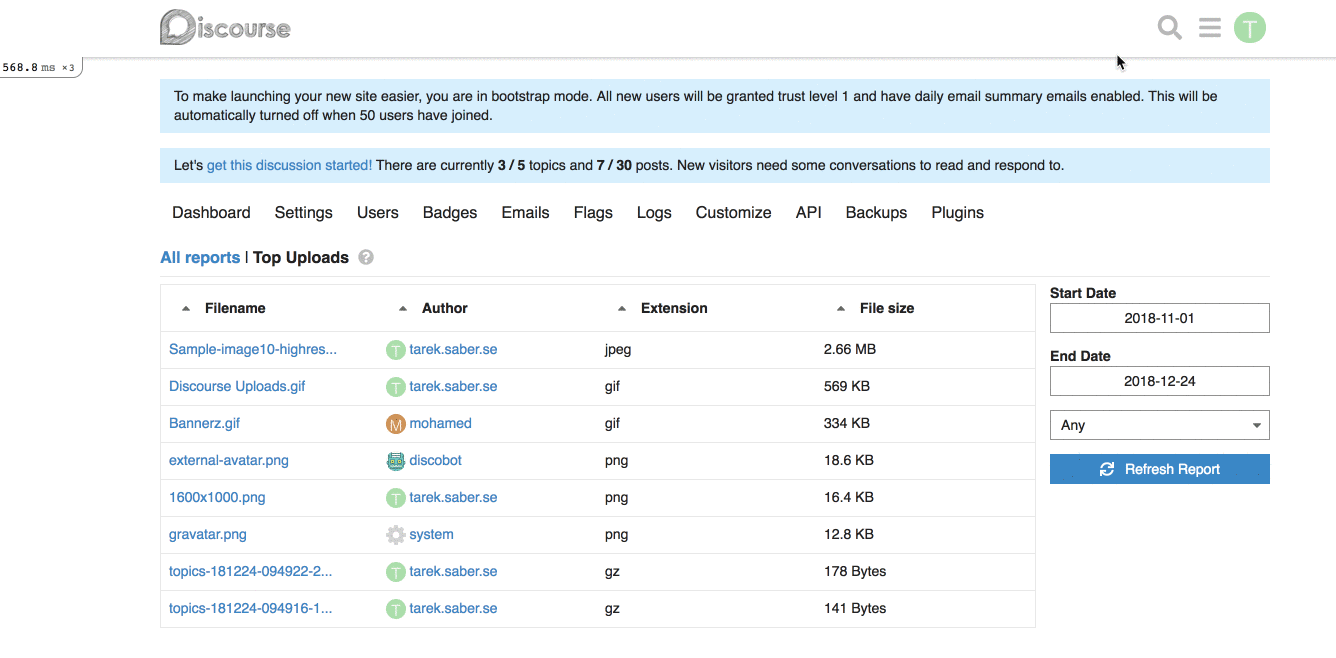This commit adds some improvements to native app banners for iOS and Android
- iOS and Android now have separate settings for native app banners
- app banners will now only show for users on TL1 and up
- app ids are now in a hidden site setting to allow sites to switch to their own app, if desired
- iOS only: the site URL is passed to the app arguments
If you turn it on now, default all users to approved since they were
previously. Also support approving a user that doesn't have a reviewable
record (it will be created first.)
This also includes a refactor to move class method calls to
`DiscourseEvent` into an initializer. Otherwise the load order of
classes makes a difference in the test environment and some settings
might be triggered and others not, randomly.
In certain edge cases, the message bus won't send the message to the
user about the updated review count and it can go out of sync.
This patch synchronizes the review count every time:
1. The user visits the "Needs Review" page
2. Every time the user performs an action
A new checkbox has been added to the Tags tab of the category settings modal
which is used when some tags and/or tag groups are restricted to the category,
and all other unrestricted tags should also be allowed.
Default is the same as the previous behaviour: only allow the specified set of
tags and tag groups in the category.
Conversely, if a user is deactivated the reviewable should automatically
be rejected.
Before this fix, if a user was not active they'd still show in the
review queue but without an "Approve" button which was confusing.
Includes support for flags, reviewable users and queued posts, with REST API
backwards compatibility.
Co-Authored-By: romanrizzi <romanalejandro@gmail.com>
Co-Authored-By: jjaffeux <j.jaffeux@gmail.com>
- The test_email job is removed, because it was always being run synchronously (not in sidekiq)
- 34b29f62 added a bypass for critical emails, to match the spec. This removes the bypass, and removes the spec.
- This adapts the specs for 72ffabf6, so that they check for emails being sent
- This reimplements c2797921, allowing test emails to be sent even when emails are disabled
Fixes two issues:
1. Redirecting to an external origin's path after login did not work
2. User would be erroneously redirected to the external origin after logout
https://meta.discourse.org/t/109755
This will allow users installing a Discourse PWA to use their active
theme colors on the generated app. Thanks for @mgiuca for the tip.
Also makes the share_target config explicit to silence Chrome warnings
Migrates email user options to a new data structure, where `email_always`, `email_direct` and `email_private_messages` are replace by
* `email_messages_level`, with options: `always`, `only_when_away` and `never` (defaults to `always`)
* `email_level`, with options: `always`, `only_when_away` and `never` (defaults to `only_when_away`)
* FEATURE: Exposing a way to add a generic report filter
## Why do we need this change?
Part of the work discussed [here](https://meta.discourse.org/t/gain-understanding-of-file-uploads-usage/104994), and implemented a first spike [here](https://github.com/discourse/discourse/pull/6809), I am trying to expose a single generic filter selector per report.
## How does this work?
We basically expose a simple, single generic filter that is computed and displayed based on backend values passed into the report.
This would be a simple contract between the frontend and the backend.
**Backend changes:** we simply need to return a list of dropdown / select options, and enable the report's newly introduced `custom_filtering` property.
For example, for our [Top Uploads](https://github.com/discourse/discourse/pull/6809/files#diff-3f97cbb8726f3310e0b0c386dbe89e22R1423) report, it can look like this on the backend:
```ruby
report.custom_filtering = true
report.custom_filter_options = [{ id: "any", name: "Any" }, { id: "jpg", name: "JPEG" } ]
```
In our javascript report HTTP call, it will look like:
```js
{
"custom_filtering": true,
"custom_filter_options": [
{
"id": "any",
"name": "Any"
},
{
"id": "jpg",
"name": "JPG"
}
]
}
```
**Frontend changes:** We introduced a generic `filter` param and a `combo-box` which hooks up into the existing framework for fetching a report.
This works alright, with the limitation of being a single custom filter per report. If we wanted to add, for an instance a `filesize filter`, this will not work for us. _I went through with this approach because it is hard to predict and build abstractions for requirements or problems we don't have yet, or might not have._
## How does it look like?

## More on the bigger picture
The major concern here I have is the solution I introduced might serve the `think small` version of the reporting work, but I don't think it serves the `think big`, I will try to shed some light into why.
Within the current design, It is hard to maintain QueryParams for dynamically generated params (based on the idea of introducing more than one custom filter per report).
To allow ourselves to have more than one generic filter, we will need to:
a. Use the Route's model to retrieve the report's payload (we are now dependent on changes of the QueryParams via computed properties)
b. After retrieving the payload, we can use the `setupController` to define our dynamic QueryParams based on the custom filters definitions we received from the backend
c. Load a custom filter specific Ember component based on the definitions we received from the backend
* First take
* Add support for sprites in themes
Automatically register any custom icons added via themes or plugins
* Fix theme sprite caching
* Simplify test
* Update lib/svg_sprite/svg_sprite.rb
Co-Authored-By: pmusaraj <pmusaraj@gmail.com>
* Fix /svg-sprite/search request
Since uploads site settings are now backed by an actual upload, we don't
have to reach over the network just to fetch the favicon. Instead, we
can just read the upload directly from disk.